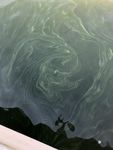Water Quality Update for September 11, 2020 - Canandaigua ...
←
→
Page content transcription
If your browser does not render page correctly, please read the page content below
Water Quality Update for September 11, 2020
This has been an interesting week for water quality. As we reported earlier this week, on Tuesday,
September 8th (the Day after Labor Day) the lake was experiencing a significant bloom event along much
of the 36 miles of shoreline. Conditions ranged from areas with light streaking and heavy suspended
algae, to full on pea-soup conditions. 22 bloom reports were filed by volunteers on 9/8 (see a sampling
of photos below). By Wednesday - also a calm, sunny day- many shoreline areas were clear, though we
did receive a few reports of mid-lake streaking. 3 bloom reports were filed on Wednesday the 9th. Many
additional shoreline and mid-lake surveys were performed by the Watershed Manager as well.
Images of blooms reported by
volunteers on Tuesday, September 9th
2020.
The cooler temps and slight north wind on Thursday and today seem to have kept blooms at bay, with
no reports coming in since Wednesday. We are seeing some foam accumulation today.
Historically, September has been the month where we experience our most intense blooms in terms of
CyanoChlorophyll values (blue green algae) and microcystin values (the toxin associated with blooms).
In September 2018, several CyanoChlorophyll values skyrocketed into the 1,000s (ug/L), when the DEC
threshold for a bloom is 25 ug/L. Many of these blooms also had high toxin values. In 2019, our highest
values were also in the month of September. While we have not yet surpassed previous year’s levels,
this is a good reminder that when blooms pop up, they need to be avoided because they have the ability
to be potentially harmful to your health or the health of our pets.Here is a table of the samples collected this week. Values are reported in ug/L, which is micrograms per
liter. DEC threshold for a bloom is 25 ug/L.
Date Location CyanoChl (µg/L)
Blue Green Algae
9/8/2020 1000 feet from shore- near Turner Road 1.34
9/8/2020 Kershaw- open water boat area 1.05
9/8/2020 Mid-lake Yacht Club 1.51
9/8/2020 Mid-lake Water Treatment Plant 0.85
9/8/2020 Shoreline- Northeast - Otetiana Point 250.7
9/8/2020 Shoreline- Northeast - Sandy Beach 509.7
9/8/2020 Shoreline- Northeast - Crystal Beach 375.8
9/8/2020 Shoreline- Southwest - South of Onanda 270.9
9/8/2020 Shoreline- Kershaw Park kayak launch / dog beach 317.8
9/8/2020 Shoreline- Northwest - North of Onanda 884.1
9/8/2020 Shoreline- Northeast - Nibawauka Beach 678.4
9/8/2020 Shoreline- Southwest - Walton Point 734.5
9/8/2020 Shoreline- Northeast - Cottage City #1 387.6
9/8/2020 Shoreline- Northeast - Cottage City #2 701.1
9/8/2020 Shoreline- Southwest - Applewood Drive 765.9
9/8/2020 Shoreline- Southeast - Fisher Road Rushville / Middlesex 34.1
9/8/2020 Shoreline- Northwest - Yacht Club 95.7
As you can see, many of the Blue Green Algae levels were very high along the shoreline areas. The four
open water samples were well below bloom threshold and were collected to get a sense of levels away
from the shoreline. We did have a few reports of blooms in the open water which is why we tell people
to use their visual indicators before recreating in the lake. In fact, on Wednesday we had the reverse
happen where the Yacht Club shoreline was clear of any visible algae and there were documented
blooms of algae out in the mid-lake area.
Several other area lakes have also seen an uptick in blooms overs the last week. Cayuga, Skaneateles,
Owasco, Keuka and Hemlock have all bloomed over the last few days as well.
Please remain aware that conditions can change quickly and to keep an eye out for signs of a bloom
before you or your pets enter the water. Please continue to use your visual indicators to look for surface
streaking, pea-soup like conditions, and green cloudy water. These areas should be avoided.
For more information throughout the week, you can check out the interactive Bloom Map from the
volunteer efforts, which is updated in real-time on the CLWA website. Click on the dots to pull up more
information on each bloom (date reported, images of blooms, description, etc).
Thanks,
CLWA & CLWCDrinking Water The six Canandaigua Lake water purveyors (the City of Canandaigua, the Village of Newark, the Village of Palmyra, the Village of Rushville, the Town of Gorham, and Bristol Harbour) are working alongside the Geneva District Office of the Health Department and the New York State Department of Health to monitor the public drinking water for the presence of toxins associated with harmful algal blooms. Samples of the public drinking water are routinely collected and sent to a State approved laboratory during the harmful algal bloom season to determine if toxins are present. Samples were collected the morning of September 8th and all treated finished water results were below the detection limit. CLWA and the Watershed Council works with the water purveyors and the Geneva District Office of the Health Department to receive the results and make them available to the public. So far this year, all results from the finished drinking water have come back non detect. Results from routine sampling can be viewed here: https://www.canandaigualakeassoc.org/drinking-water-test-results/. Private water system users that draw water from the lake (those who are using a home treatment system where water does not come from a public water treatment plant) may face challenges during active blooms due to the varying capabilities of household treatment units to remove cyanotoxins. We encourage those using a private system to use bottled water during active blooms and to work with a professional water service company to evaluate their treatment system.
You can also read





















































